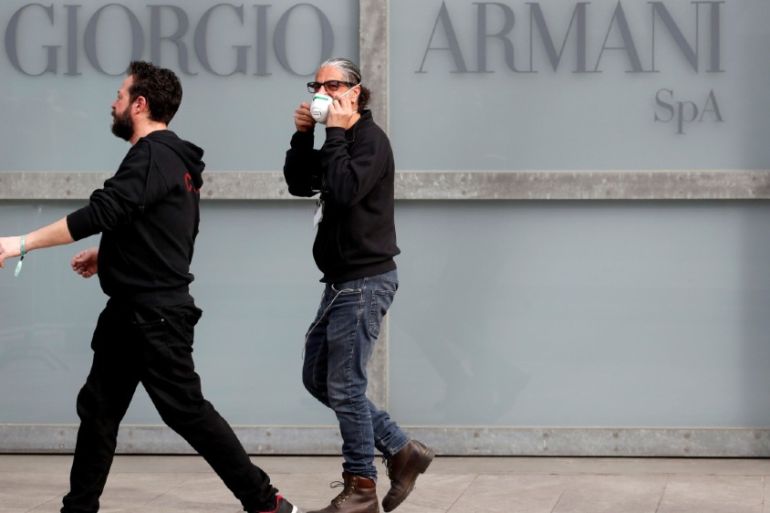Italy’s designers urge Rome to relax fashion sector restrictions
Businesses with a passion for fashion say current restrictions risk damaging the industry beyond repair.

Italy‘s fashion leaders called on the government on Thursday to loosen restrictions imposed in response to the coronavirus crisis to allow them to resume some production, warning that a prolonged lockdown risked irreparably damaging the sector.
“Fashion is a seasonal industry, and certain dates are not compressible. Not reopening shortly would mean giving up almost a year’s turnover,” said Carlo Capasa, the chairman of Italy’s National Chamber for Italian Fashion (CNMI), in an online interview on the website of daily Corriere della Sera.
Keep reading
list of 3 itemsItaly’s migrants living through an emergency within an emergency
Europe virus outbreak: Small steps taken to ease lockdown rules
Current lockdown measures in Italy – the country with the third-highest number of confirmed cases after the United States and Spain – have been imposed until May 3. The country’s death toll increased by 525 on Thursday, down from an increase of 578 the day before, but the number of new cases accelerated sharply to 3,786 from a previous 2,667.
There were 2,936 people in intensive care on Thursday compared with 3,079 on Wednesday – a 13th consecutive daily decline.
The government has not disclosed how and when it will start easing a nationwide ban on business activities deemed as non-essential.
Fashion and textile plants throughout the country have shut as they do not fall into the category of essential businesses.
Many labels have reconverted production to make medical devices such as masks and medical overalls to meet rising demand during the emergency.
With a turnover of 95 billion euros ($103bn) and 600,000 workers, Italy’s fashion and textile industry is the second-most important nationwide.
It accounts for a 41 percent share of the sector in Europe, followed by Germany’s fashion and textile industry, which represents 11 percent of the total.
Capasa suggested April 20 as a date to gradually reopen manufacturing activities in order to deliver fall/winter collections on time to shops around the world, and to start production of spring/summer collections.
“We are closed, but other countries like France, Spain, Portugal, Turkey are starting to reopen,” said Claudio Marenzi, who is in charge of fashion at business lobby Confindustria, pointing out that the ban also had implications for Italy as a supplier.
“This means that some brands may decide to switch to another supply chain, which in Italy is mainly made up of small companies. And once a company closes, you lose the know-how and you never recover,” he added.
Confindustria Moda represents 65,000 companies in the textile, fashion and accessories sectors. Most are small firms with only 15-20 employees, with sales highly dependent on foreign buyers.
Marenzi said Confindustria Moda had signed an agreement with unions over stringent health and security measures to adopt at production sites once these are allowed to reopen.
“[The deal] shows that entrepreneurs and workers are aligned in their will to restart activities and save the Italian fashion industry,” he said.
“An economic epidemic could cause more lasting damage than the health one. If we have to live with this virus for so long, then let’s live with it,” Marenzi said, adding that if the industry could safely make masks and gowns, it could also make clothes.
The International Monetary Fund forecast this week that Italy’s economy – the eurozone’s third largest – would contract by 9.1 percent this year, the steepest drop in gross domestic product of any large European economy.
A 25 billion euro ($27bn) stimulus package in March increased financing for Italy‘s health service and boosted funds to supplement the income of the self-employed and workers temporarily laid off.